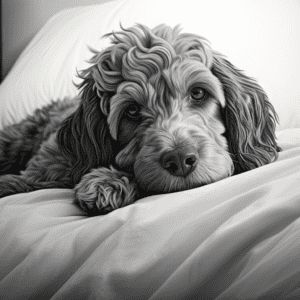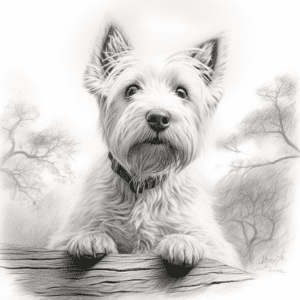Safe Environments
Ensuring a safe environment for your dog is as crucial as providing proper nutrition and exercise. A safe environment not only prevents accidents but also helps your dog feel secure and comfortable, both at home and while traveling. In Ireland, where many homes and landscapes present unique challenges, it’s essential to consider specific safety measures.


Embark on a journey filled with pawprints and happiness. Dogs bring a unique light into our lives, offering companionship, love, and countless reasons to smile.
Home Safety
Creating a dog-friendly home involves more than just a cozy bed and toys; it’s about ensuring that your living space is free from hazards that could harm your dog.
- Identifying Hazards: Common household items like certain plants, foods, and small objects pose risks to dogs. Ensure toxic substances like cleaning agents, certain human foods (like chocolate, grapes, and xylitol), and small items that can be swallowed are out of reach.
- Secure Spaces: Designate a safe area for your dog, especially when they are home alone. This could be a dog-proofed room or a crate if they are crate-trained.
- Preventing Escapes: Ensure fences are secure and gates are latched to prevent your dog from wandering off. Check for small gaps where a smaller dog might squeeze through.
- Flooring: Slippery floors can be hazardous, particularly for older dogs or breeds prone to joint issues. Non-slip rugs or mats can provide better traction.




Travel Safety
Traveling with your dog, whether for a day trip or a longer vacation, requires planning to ensure their safety.
- Car Travel: Always secure your dog in the car. Use a well-fitted harness, a crate, or a dog guard. This prevents them from being a distraction and protects them in case of sudden stops.
- Understanding Travel Regulations: Familiarize yourself with pet travel regulations in Ireland, especially if you plan to travel abroad. This includes microchipping, vaccinations, and pet passports.
- Pet-Friendly Accommodations: Research pet-friendly accommodations in advance. Consider places that have safe areas for your dog to play and relax.
- Regular Stops: On longer journeys, plan for regular stops to allow your dog to stretch, relieve themselves, and drink water.
International Travel from Ireland to the UK and EU
Traveling with your dog from Ireland to the UK or other EU countries involves specific requirements to ensure a smooth and safe journey for your pet.
Pet Passport and Microchipping: For travel within the EU, including the UK, your dog will need a pet passport. This passport documents their microchip number and proof of rabies vaccination. Microchipping is a mandatory requirement and must be done before the rabies vaccination.
Rabies Vaccination: Your dog must be vaccinated against rabies. There is a 21-day waiting period after the first rabies vaccination before you can travel. Keep in mind that rabies boosters must be kept up to date.
Tapeworm Treatment (for travel to the UK): Dogs entering the UK from Ireland need to be treated for tapeworms (Echinococcus multilocularis). The treatment must be administered by a vet 24 to 120 hours (1 to 5 days) before entering the UK.
Travel by Air: When flying, check with the airline for their specific pet travel policies. Some airlines allow small dogs in the cabin, while others may require pets to travel in the cargo hold. Ensure you have an IATA-compliant pet crate.
Travel by Ferry: Many ferries between Ireland and the UK or other EU countries accommodate dogs. Check with the ferry company for their pet travel policies. Some offer pet-friendly cabins, and kennels, while others may allow dogs to remain in vehicles for shorter journeys.
Preparing Your Dog for Travel: Acclimate your dog to their travel crate well in advance. Ensure they are comfortable and secure in it. It’s also a good idea to have your dog accustomed to longer journeys if they are not already.
Healthcare Preparation: Consult with your vet before traveling. Ensure all vaccinations are up to date and discuss any concerns, especially if your dog has a medical condition.
Legal and Regulatory Changes: Be aware of any changes in pet travel regulations, especially with ongoing adjustments post-Brexit. Keep informed of the latest requirements for pet travel between Ireland, the UK, and other EU countries.
Find loyalty and affection in every wag. Dogs are more than pets; they are loyal friends, offering unconditional love and endless happiness
Our Latest Posts


Puppy Essentials – Preparing for a New Arrival
Bringing a new puppy home is an exciting adventure filled with love and learning. By following this guide, you’ll be well on your way to providing a safe, nurturing environment for your new family member. Remember, patience, consistency, and love are key to raising a happy, healthy puppy. Embrace every moment of this rewarding journey with your furry friend!


Foods That Humans Eat That Are Toxic to Dogs
As dog owners, we often treat our furry friends as part of the family, sharing our lives and sometimes even our meals with them. However, what’s tasty and harmless for us can be dangerous, even fatal, for our canine companions. It’s crucial to be aware of the human foods that can pose serious health risks to dogs. This knowledge not only ensures the safety of our pets but also helps us make informed decisions when it comes to feeding them.


Understanding and Managing Separation Anxiety in Dogs
Separation anxiety in dogs is a common but often misunderstood condition. It’s more than just a pet missing its owner; it’s a serious behavioral issue that can significantly impact the well-being of both dogs and their owners. Recognizing and addressing this emotional distress is crucial for maintaining a happy, healthy relationship with your canine companion
